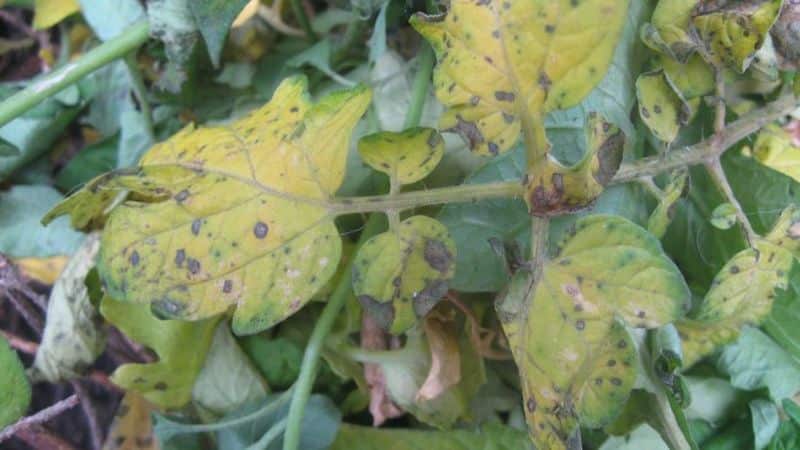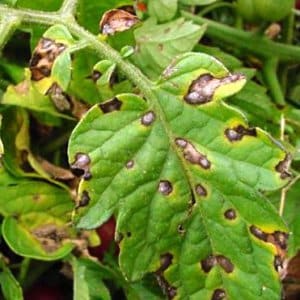Why black spots may appear on tomato leaves in a greenhouse and how to get rid of them: saving the crop effectively
Vegetable growers who grow tomatoes in greenhouses often encounter various diseases of the nightshade family. Many diseases can be recognized by the main symptom - the appearance of spots on leaves and fruits.
What to do if black spots appear on the leaves of tomatoes in a greenhouse, how to correctly identify the disease and what control methods will help cope with it - you will learn all this from our article.
Why do spots appear?

The appearance of spots on tomato tops is a sign of the development of diseases: fungal, bacterial or viral. Some diseases can destroy the entire crop, so this symptom cannot be ignored. Infections are often transmitted from other garden crops - for example, potatoes and eggplants.
There are cases when no deviations in the development of tomatoes or signs of disease are observed, but spots appear on the leaves. The problem may be a lack or excess of mineral fertilizers.
Important! Stains can appear due to improper care or if the location for the garden bed is chosen incorrectly.
Light spots are not necessarily a sign of disease; they may be the result of sunburn on the plant. They also often appear when the roots of seedlings are damaged during transplantation.
Types of stains
The formations can be small, large, dot-like, or completely cover the entire sheet.Such spots most often lead to thinning of the leaf blade and its drying out.
With various rots, the spots are more moist and dense. Bacterial diseases manifest themselves as small formations that can acquire white, yellow, gray, brown and black colors.
Diseases leading to spotting
To eliminate the problem, you must correctly determine the cause of its occurrence.
The following diseases lead to the appearance of spots:
- Fungal: gray rot, fomoz, late blight, cladosporiosis, alternaria, goblet rust, septoria, root rot.
- Bacterial: bacterial black spot, bacterial canker, stem necrosis, wet rot, blossom end rot.
- Viral: chlorotic curl, mosaic, tomato streak.
Soil phytotoxicity
The formation of spots on seedlings is possible due to improper use of pesticides and fertilizers. Imbalance of substances negatively affects the development and productivity of the plant. Calcium deficiency is one of the factors leading to the development of various diseases.
Determining the cause
Each disease has its own distinctive symptoms. It is important to learn how to correctly determine the source of spotting on tomatoes so as not to harm the seedlings.
Bacterial diseases
Bacterial spot is caused by Xanthamonas microorganisms, which have 4 phenotypes. Bacteria can be found in seed and plant tops. These microorganisms do not live long in the soil. The disease progresses at humidity above 70% and air temperature 25-30 °C. If action is not taken immediately, the plant will dry out.
The main signs of bacterial diseases:
- the appearance of olive spots with an oily consistency;
- the formations acquire a dark shade with an outer light rim;
- spot size - 5-6 mm;
- Both stems and fruits can be affected;
- the plant loses 50-100% of its leaves.
With bacterial black spot, plants look stunted and underdeveloped. Necrosis of the stem core is determined by brown spots that begin to crack over time. With wet rot, the stems and fruits become brown and soften—the plant begins to rot from the inside.
Bacterial canker is characterized by the appearance of small white spots on the fruit, wilting of the leaves and the formation of brown growths on the petioles.
Apical rot can be recognized by the formation of a dry brown spot on the top of unripe fruits, which increases in size over time. The green mass does not suffer from this disease.
Fungal diseases
Spots are formed due to the activity of fungi. Plant damage begins from the stem; in the initial stages, the gardener may not immediately recognize the threat. The pathogen spreads quickly and infects leaves and fruits. The disease is typical for greenhouses and greenhouses.
Factors that provoke the development of the disease: high humidity, abundant watering, high air temperature, excess nitrogen fertilizers.
Important! With fungal diseases, the plant may die 5-10 days after infection.
Diseases caused by fungi:
- Gray rot - gray spots form on the plant, a white fluffy coating and rotting areas appear on the fruits.
- White rot - tomatoes begin to crack, soften and become covered with white spots. The disease quickly spreads to the leaves and stem: the leaf blade becomes thinner, loses its color, and white dots and spots form.

- Fomoz - small brown or black spots appear on the leaves, which gradually increase in size and darken. Concentric circles form on the stems, and on the fruits, brown spots appear near the stalk.
- Late blight - spots appear at the bottom of the stem, then the disease affects the leaves and fruits. The green mass, flowers and ovary dry out and fall off.
- Cladosporiosis - gray or olive spots with a fluffy coating form on the lower part of the leaf, and small yellow formations on the upper part. Leaves, flowers and ovaries dry out and fall off.
- Glass rust - yellow dots appear on the leaves, which gradually increase in size and acquire a rusty color. The diseased plant becomes deformed and dries out.
- Alternaria blight or macrosporiosis — rounded yellow-brown spots form on the leaves, gray-brown spots appear on the stems. The size of the spots is up to a centimeter. Fruits may be affected. The disease appears immediately after planting seedlings in the ground.
- Septoria - smooth gray or white spots with a dark border appear on the leaves. The disease first affects the lower leaves and then spreads throughout the plant. The green mass curls, dries and falls off.
- Root rot - the root collar area becomes black, rust-colored spots appear on the trunk, the foliage becomes covered with a white coating, after which the plant withers.
Viral diseases
Tomatoes are most often affected by the following diseases:
- tomato streak — light areas of necrosis appear throughout the plant, resembling streaks. Over time, the formations merge, the green mass dries out, and the fruits crack;
- mosaic - manifests itself in leaf mottling, some areas become white, others dark.Outgrowths form on the underside of the leaf and necrosis of the tomatoes occurs;
- chlorotic curl - a type of mosaic caused by a virus carried by whiteflies. In addition to the appearance of spots of various shades, the leaf blade may curl, causing the bush to become curly.
Ways to fight

Each disease requires its own approach and method of treatment.
Bacterial diseases
The development of bacterial diseases can be prevented by treating seeds. For prevention use:
- 3-5% sodium hydrochloride;
- 6-8% calcium hydrochloride;
- trisodium phosphate.
Important! The material is soaked in hydrochloride solutions for 10-30 minutes, in trisodium phosphate for 60 minutes.
Seedlings and adult bushes are treated with the following preparations:
- "Fitolavin";
- "Fitosporin-M";
- "Acrobat";
- "Baktofit";
- "HOM";
- Bordeaux mixture.
Fungal diseases
When affected by fungal diseases, fungicides are used, Bordeaux mixture, copper sulfate and garlic infusion.
- The following drugs are effective against gray rot: “Acrobat MC”, “Profit Gold”, “Abiga-Peak”, “Previkur”. As a preventative measure, the beds are treated with copper sulfate, garlic infusion and Bordeaux mixture.
- A plant infected with white rot is pulled out and burned. Medicines against this disease are not effective. The best protection is prevention: heating the seed material in the oven or treating it with a manganese solution. Before planting seedlings in the ground, disinfection is carried out with copper sulfate, urea or zinc sulfate.
- Phomasis cannot be cured - tomatoes are pulled out and burned, and the soil should be disinfected.To reduce the likelihood of developing the disease, it is important to control air humidity and avoid using manure and nitrogenous fertilizers.
- Late blight is treated with drugs: “Previkur”, “Findazol”, “Horus”, “HOM”, “Topaz” and the antibiotic “Trichopol”. Treating seedlings with Bordeaux mixture, copper sulfate, garlic infusion and manganese solution also helps. At the end of the season, all plant residues are burned and the soil is disinfected.
- For cladosporiosis the affected leaves are torn off, the plants are treated with the preparations “HOM” and “Effekton-O”. The fungus can also be removed using Bordeaux mixture, copper sulfate and garlic infusion.
- Glass rust can be defeated with the help of such drugs: “Oxychom”, “Figon” and “Fundazol”. Folk remedies are also effective: infusion of marigolds or horsetail, soda ash.
- Alternaria blight treated with fungicides: Ditan-M45, Antrakol-70, Quadris, Infiniti, Flint.
- For septoria the affected tomatoes are destroyed, the greenhouse and soil are disinfected. Prevention is by spraying the beds with a 1% solution of Bordeaux mixture or a 0.3% suspension of copper oxychloride.
- Root rot treated with the drug "Ridomil Gold", to prevent the disease, seeds, soil and seedlings are treated with the drugs "Pseudobacterin-2" and "Rossa".
Viral diseases
Tomato diseases caused by viruses are practically untreatable. We recommend choosing varieties that are resistant to disease: Semko, Madison, Sors, Zhenaros, Anyuta, Cunero.
At the initial stage of the mosaic, a solution of serum with the addition of Farmayod-3 will help save the crop. For chlorotic curl, the bushes are treated with the preparations “Citkor” and “Fitover”.With further development of the disease, the plants are pulled out, disinfected with trisodium phosphate, and then burned.
Advice from experienced gardeners
Vegetable growers recommend not to neglect simple rules that will help protect seedlings from diseases and phytotoxicity of the soil:
- Purchase seed material from a trusted manufacturer and certified retail outlets.
- Always treat seeds before planting.
- Do not neglect soil disinfection - disinfection is carried out before planting seedlings and after harvesting.

- Follow the rules of crop rotation - tomatoes are planted in the same bed only after 3-4 seasons.
- If the site is located in a dry area, peat or turf soil should be added to it before planting seedlings.
- Do not thicken the plantings - there should be 70 cm between plants.
- Weed out weeds in a timely manner.
- Do not flood the plants with water.
- Mulch tomato beds with straw or polyethylene.
- Ventilate the greenhouse regularly.
- Disinfect garden tools.
- Monitor air temperature and humidity indicators.
- Control the amount of nitrogen fertilizers.
- Destroy aphids, carriers of pathogens.
- After harvesting, burn all plant residues.
If the disease does manifest itself, it is important to begin treatment immediately. Delay in this matter will lead to loss of harvest.
Conclusion
There are many reasons why spots appear on tomatoes. The symptoms of bacterial diseases are similar, so the same drugs are used in treatment. Fungal diseases are more diverse and there are many medications for them, but pathogens react equally to Bordeaux mixture, copper sulfate and garlic infusion.
Treatment for viral diseases is useless - the plants are destroyed and the beds are disinfected.Reviews from vegetable growers show that preventive measures should not be neglected; they are the key to obtaining a bountiful harvest.